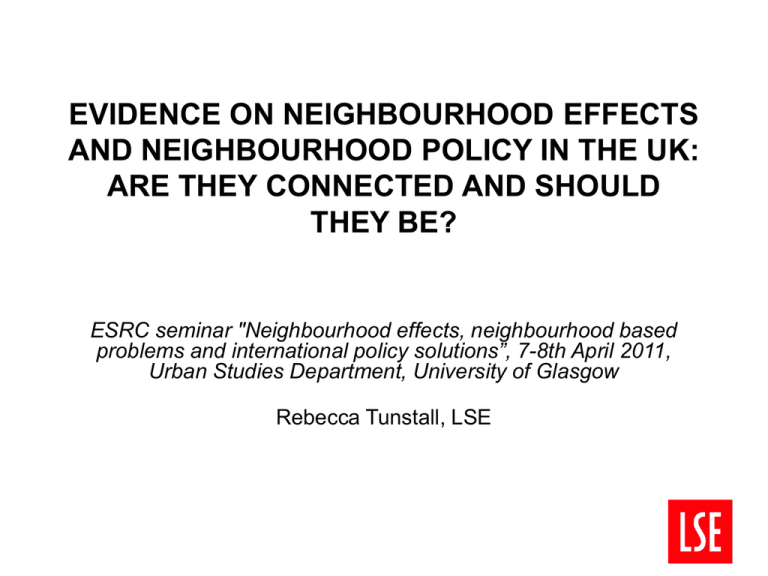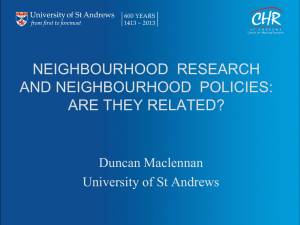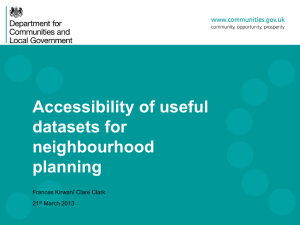Presentation - Neighbourhood Effects
advertisement

EVIDENCE ON NEIGHBOURHOOD EFFECTS AND NEIGHBOURHOOD POLICY IN THE UK: ARE THEY CONNECTED AND SHOULD THEY BE? ESRC seminar "Neighbourhood effects, neighbourhood based problems and international policy solutions”, 7-8th April 2011, Urban Studies Department, University of Glasgow Rebecca Tunstall, LSE 1 Introduction A. Some new evidence on neighbourhood effects - Tunstall, R; Lupton, R; Kneale, D and Jenkins, A (2011a) Teenage housing and neighbourhoods and adult outcomes: Evidence from the 1970 cohort study CaseReport No.64 London: CASE - Tunstall, R; Lupton, R; Kneale, D and Jenkins, A (2011b) Growing up in social housing in the new millennium: Housing, neighbourhoods and early outcomes for children born in 2000 CasePaper No.143 London: CASE - Postcode discrimination in employment - forthcoming study B. Discussion of the relationship between evidence of neighbourhood effects and policy C. An experiment! 2 A. Introduction The first pair of studies develop the findings of two previous reports (Feinstein et al, 2008, Lupton et al, 2009). - The earlier reports examined housing in childhood for those born in 1946, 1958, 1970 and 2000, and its relationship with adult outcomes across a range of measures (except for those born in 2000). - They found as yet unexplained connections between being ‘ever’ in social housing in childhood and worse adult outcomes on an overall measure of deprivation and a range of individual measures for those born in 1958 and in 1970 (but not for those born in 1946) (Feinstein et al, 2008, Lupton et al, 2009). 3 The aims of the research The pair of studies uses: 1) the British Cohort Study, whose members were born in 1970 and 2) the Millenium Cohort Study whose members were born in 2000. One of the aims of the pair of projects was to explore whether features of social housing neighbourhoods might constitute either all or part of what appeared to be a ‘tenure effect’. The studies were funded by the Homes and Communities Agency and the Tenant Services Authority, and completed with help from colleagues at the Centre for Longitudinal Studies at the Institute of Education, who assisted in linking cohort data to neighbourhoods. 4 1st study: Using the British Cohort Study The British Cohort Study follows a sample of people born in Great Britain in 1970 as they have grown up. Data were collected at birth, at age 5, and 10, 16, 26, 30, and 34. Childhood waves of data collection involved interviews with parents. Children were also tested and as they entered adolescence they were interviewed. 5 The British Cohort Study We report data for a sub-sample of cohort members: •Born in England, rather than Great Britain (in contrast to Feinstein et al, 2008 and Lupton et al, 2009); •Included in data collection at three points, in 1970, 1986 and 2004; •For whom full data was collected on the main variables used in this analysis. This produces a sample of about 4,000 people in all (the British Cohort Study included about 9,000 people born in 1970 who were tracked for at least some variables all the way through to 2004, across the whole of Great Britain). 6 Characterising teenagers’ neighbourhoods We used the 1991 Census to characterise cohort members’ 1986 neighbourhoods. (This was the closest date match available; other research suggests that the deprivation of neighbourhoods relative to others changes slowly). We looked at: • Small neighbourhood scale (Enumeration Districts, since replaced by Output Areas, about 100-150 households); and • Large neighbourhood scale (electoral wards, about 2,200 households). We examined: • Neighbourhood deprivation: what decile of neighbourhoods the cohort member’s address was in using the ‘Carstairs’ index of deprivation (similar to the IMD, but available for 1991); and • Neighbourhood tenure mix: whether or not the neighbourhood was ‘social housing dominated’ 7 Neighbourhood deprivation: Proportion of teenagers in each tenure found in small neighbourhoods in different deciles of our deprivation index 1991, at age 16 in 1986 30 Percentage in this kind of neighbourhood 25 20 15 10 5 0 Most deprived 10% 2nd most 3rd 4th Social renting 5th 6th Private rented and other 7th 8th Ow ner occupied 9th Least deprived 10% 8 Characterising outcomes in adulthood We examined outcomes for cohort members at the age of 34 in 2004. We used 11 measures of outcomes: 1) In paid employment/not; 2) Claiming means tested benefits/not; 3) Literacy or numeracy problems/none; 4) Depressed/not; 5) Suffering malaise (mild depression)/not; 6) Taking regular exercise/not; 7) Low life satisfaction/not; 8) Smoking at least 1 cigarette a day/not; 9) Highest qualifications; 10) Self-rated health; and 11) Self-efficacy. 9 Odds ratios for raw outcomes at age 34 for those in both rented tenures as teenagers, compared to those in home ownership Exercise Health (Improvement) Employed Highest Qualification (Additional) Low Life Satisfaction Malaised Literacy or Numeracy Problems Low Self Efficacy Depressed Smokes cigarettes Received Means Tested Benefits 0 1 2 3 4 5 6 Odds Ratio Social Housing Private Rental 10 The role of teenage housing tenure in explaining adult outcomes: Controls We controlled for individual and family advantage, with 2 sets of controls. The small set of controls included 8 measures: 1) Index of Family Advantage; 2) Mothers’ age at the birth of her first child; 3) Whether mother had moved away from her home region by the birth of first child; 4) Cohort member’s weight at birth; 5) Whether cohort member was born into a lone parent family; 6) Whether cohort member was in a lone parent family at 16; 7) Number of siblings resident in the household at 16; and 8) Region lived in at 16. The large set of controls included 56 variables, as used in Feinstein et al (2008) and Lupton et al (2009). 11 Odds ratios for outcomes at age 34 for those in social rented housing as teenagers, compared to those in home ownership as teenagers (raw outcomes and various controls) Exercise )Health (Improvement Employed )Highest Qualification (Additional Low Life Satisfaction Malaised Literacy or Numeracy Problems Low Self Efficacy Depressed Smokes cigarettes Received Means Tested Benefits 0 0.5 1 1.5 2 2.5 3 3.5 4 12 Odds Ratio No Controls Index of Advantage Small set of controls 4.5 Large set of controls The role of teenage neighbourhoods in explaining adult outcomes… 13 Exercise Health (Improvement) Employed Highest Qualification (Additional) Low Life Satisfaction Malaised Literacy or Numeracy Problems Low Self Efficacy Depressed Smokes cigarettes Received Means Tested Benefits 0 0.5 1 1.5 No Controls Small set and larger area deprivation Small set and larger area tenure mix 2 2.5 3 3.5 Small set Odds Ratio Small set and smaller area deprivation Small set and smaller area tenure mix 4 4.5 14 After applying controls for family and individual circumstances with both the small and large sets of controls, taking neighbourhood characteristics into account modified somewhat* the relationship seen between teenage tenure and adult outcomes. Thus, the associations between tenure and outcomes we have found can be described as likely to be partly* due to the characteristics of the neighbourhoods that homes in different tenures were found in: –in terms of deprivation; and –in terms of tenure mix; –at both small neighbourhood scale (about 100-150 households) and larger neighbourhood scale (about 2,200 households). 15 2nd study: Using the Millennium Cohort Study The Millennium Cohort Study is a longitudinal study of children born in 2000. Almost 15,000 children have been tracked to the age of 5 in 2006. The 2006 study includes interviews with parents and tests on children. We report data for cohort members born in England, rather than Great Britain (in contrast to Feinstein et al, 2008 and Lupton et al, 2009). 16 Tenure and neighbourhoods at age 5 in 2006 We used the Index of Multiple Deprivation 2007 to characterise the Lower Super Output Areas (LSOAs, neighbourhoods typically with 600 homes and 1,500 people) in which cohort members were living in at age 5. Again the situation of children in social housing stands out. 17 Percentage of children in each housing tenure in LSOAs in Proportion of 5yr olds in each tenure in this kind of nhood different deciles of the IMD 2007, at age 5 in 2006 30 25 20 15 10 5 0 Most 2nd most deprived 10% 3rd 4th 5th Social renting 6th Private rented 7th Owned 8th 9th Least deprived 10% 18 Early outcomes at age 5 in 2006 We examined early developmental outcomes through scores on tests of vocabulary and drawing skills at age 5. 19 0 20 40 60 Mean test scores by housing tenure, age 5 in 2006 owned LA/HA rent naming vocabulary private rent pattern construction weighted estimates 20 0 20 40 60 Mean test scores by neighbourhood IMD 2007 decile, age 5 in 2006 poorest 2 3 4 5 naming vocabulary weighted estimates 6 7 8 9 richest pattern construction 21 The role of housing tenure and neighbourhoods in early outcomes We carried out regression analysis on test scores to control for a small number of factors: i. Whether or not children lived in the most deprived tenth of neighbourhoods; ii. Index of Family Advantage )based on parents’ education and occupational status); iii. Mother’s age at first birth; iv. Family structure; v. Number of siblings. 22 Regression results Half* the gap in test scores between children in both rented tenures and those in home ownership was removed using the small set of controls Thus, the typically high deprivation levels of social housing neighbourhoods, included in these controls, appear to constitute part* of the link seen between tenure and early childhood outcomes. Individual and family factors also appear to constitute part* of the link. 23 Summary of both studies The typically high deprivation levels of social housing neighbourhoods (and for the 1st study, concentrations of social housing) appear to constitute part* of the link seen between social rented tenure and various outcomes for two generations. 24 3rd study: Experimental correspondence test for postcode discrimination in employment Discrimination by outsiders including in employment one of main hypothesised mechanisms for neighbourhood effects Residents of deprived areas, their advisors, and members of the public believe this discrimination takes place - and some employers have admitted to it… Results due late 2011… 25 B. The relationship between evidence of neighbourhood effects and neighbourhood policy Has 1st, 2nd project evidence been connected to policy (to date)? No. No ‘policy implications’ in reports UK housing and neighbourhoods policy environment 2009-2010 not ready for research Should this research be connected to policy? Perhaps not. 26 A very basic model of policy making and the role of evidence in it… 1) P is a social/economic problem 2) Is P associated with/possibly caused by factor X? (a role here for specialist factor X researchers) 3) If yes, )specialist researchers’) policy implication = change/remove X 27 HM Treasury’s model of policy making and the role of evidence… HM Treasury’s Green Book constitutes binding guidance for all central government departments and agencies in the UK: “all new policies, programmes and projects, whether revenue, capital or regulatory, should be subject to comprehensive but proportionate assessment… The essential technique is option appraisal, whereby government intervention is validated, objectives are set, and options are created and reviewed, by analysing their costs and benefits” )HMT 2003 p1-3). 28 Have neighbourhood policies been based on evidence about neighborhood effects to date? Eg UK 1997-2010: Largely, no: - Absence of timely evidence - Presence of other rationales 29 Have neighbourhood policies been likely to have any effect on neighbourhood effects? Eg. UK 1997-2010: Some, if limited, effects on deprived neighbourhood outcomes in education, worklessness… Some, limited, change in characteristics of neighbourhoods we attribute neighbourhood effects to: -population composition -neighbourhood infrastructure including services -relationship with other areas. Not clear what critical thresholds are and if they have been passed, or how many neighbourhoods Many policies compensated for individual deficits 30 Housing, neighbourhood policy implications of evidence on neighbourhood effects: Is it any of our business? Neighbourhood effects can be effects on anything… How much should housing and neighbourhood policy attempt to alter outcomes such as: paid employment, means tested benefits, literacy or numeracy problems, depression, exercise, life satisfaction, smoking, qualifications, self-rated health, selfefficacy (1st study); pattern construction tests at age 5 (2nd study)? Can it be our business alone - do we understand enough about these outcomes? 31 Is it worth trying? Neighbourhood effects are ‘small’ How much social resource should we devote to trying to change test scores at age 5 (2nd study)? - Results at age 5 on similar tests were associated with* achievement in reading and maths at age 10 and qualifications and wages at age 30 (Feinstein and Duckworth, 2006). - Children in most deprived decile of neighbourhoods scored about 1.5 points lower* than other after controls. These are questions for policymakers – but they need help. 32 Is something else also/more worth trying? Housing and neighbourhood policies – especially the highest economic/social cost ones - are not the only options •Eg remedial not preventative policies – for 1st study outcomes, employment support, smoking cessation, literacy classes, exercise clubs… •Eg for 2nd study outcomes... …child test scores are also associated with gender (Schoon et al, 2010), ethnicity (Dearden and Sibieta, 2010), parents’ employment status and financial situation, parenting practices, parents’ relationship quality, motherchild relationships and mother’s wellbeing and self-esteem (Jones, 2010) 33 Lo ne pa ep ta y 3 ild (c o 0+ re d to 1 30 si ) b) -3 4 ) ) nt s ni ng pa re ow to 2 m p to m pa (c o m p to ) 9) -3 4 er 30 ot h ) 1) ni ng to m os t) ow to to p m p om (c o (c m p to m p to (c o m p m p (c o (c o ed he r4 ge re nt e 20 cil he ru ch M ot ta O nl re n at e M ot de (c o s (c o sib tile 3+ in i te d qu lr en ed riv Pr iv td cia fa m ily So ta dv as M os Le Test score gap Gaps in pattern construction test scores for Millenium Cohort children in different situations, after controls for neighbourhood deprivation, family advantage and other individual and family factors, age 5 in 2006 5 4 3 2 1 0 34 Finally: An emerging gap between researchers and policymakers? “the conventional policy wisdom is… so dominant” )Galster 2007 p524), But the ‘policy thrust’ towards creating more socially mixed neighbourhoods for poorer residents “has not been without its skeptics” (2007 p524) … Kearns, Atkinson, Kearns, Meen, Musterd, Ostendorf, Freidrichs, Cole, Goodchild, Delorenzi… 35 And subsequently: “the main sources of low incomes are to be found in earnings, employment, and demographics, not in neighbourhood characteristics” (Bolster et al. 2007 p234) “neighbourhood effects are small compared to the effects of individual and family characteristics" (van Hamm and Manley 2009 p) “evidence…. does not support the conclusion that NEs are quantitatively all that important… the conclusion for policy is to reduce overall income inequality rather than to promote mixed communities” (Cheshire 2007 p34) 36 Bond et al’s comments “It seems likely… that the reviews [of evidence on mixed tenure] used by policymakers could be less thorough or rigorous than they might be” (p70). Bond, L; Sautkina, E and Kearns, A )2010) ‘Mixed messages about mixed tenure: Do reviews tell the real story?’ Housing Studies 26(1) pp69-91 37 The UK Social Research Association’s view of policy making and the role of evidence… “Social researchers may not be in a position to prevent action based on their findings. They should, however, attempt to pre-empt likely misinterpretations and should counteract them when they occur” (SRA 2003 p18). 38 C. Action research! Q. Is there a latent consensus about the implications of evidence on neighbourhood effects for housing and neighbourhoods policy, and if so, what is it? A ‘Delphi’ review )Linstone and Turoff 1972) 1) Gathering individual views; 2) Feedback to individuals of collated, anonymised individual views; 3) Feedback from individuals on collated views… 39 Is future neighbourhood policy likely to have an effect on neighbourhood effects? What is a ‘neighbourhood policy’? The most important neighbourhood policies are mainstream public policies, many incorporating some redistribution and/or or anti-segregation effects (and private policies) UK’s new neighbourhood policy 2010-: Another experiment - Withdrawal of most ABIs - Spending cuts - ‘Localism’ Potential change in characteristics of neighbourhoods we attribute neighbourhood effects to: -population composition -neighbourhood infrastructure including services -relationship with other areas 40 References Dearden, L and Sibieta, L (2010) 'Ethnic Inequalities in Child Outcomes.' In K. Hansen, H. Joshi and S. Dex, Children of the 21st Century: The first 5 years, Bristol: Policy Press, pp 169-184.Jones, 2010 Feinstein, L. and Duckworth, K. (2006) Development in the early years: Its importance for school performance and adult outcomes Wider benefits of Learning, Research Report no. 20, London: Centre for Research on the Wider Benefits of Learning. Feinstein, l., Lupton, R., Hammond, C., Mujtaba, T. and Sorhaindo, A. with Tunstall, R., Richards, M., Kuh, D. and Jonson, J. (2008) The public value of social housing: A longitudinal analysis of the relationship of housing and life chances, London: Centre for Research on the Wider Benefits of Learning, Institute of Education, University of London. Galster, G )2007) ‘Should policymakers strive for neighbourhood social mix? An analysis of the Western European evidence base’ Housing Studies 22(4) pp523-545 HM Treasury (2003) The Green Book: Appraisal and evaluation in central government: Treasury Guidance London: TSO Linstone, HA and Turoff,M (2002) The Delphi method: Techniques and applications (downloaded from http://is.njit.edu/pubs/delphibook/ch1.html, orginally published 1972) Lupton, R.; Tunstall, R.; Sigle-Rushton, W.; Obolenskaya, P.; Sabates, R.; Meschi, E.; Kneale, D. and Salter, M. (2009) Growing up in social housing in Great Britain: The experience of four generations, London: Homes and Communities Agency. Mullins, D (2006) ‘Exploring Change in the Housing Association Sector using the Delphi Method’ Housing Studies, 21 (2), 227-251 Schoon, I., Cheng, H. and Jones, E. )2010) ‘Resilience in children’s development’ in K. Hansen, H. Joshi and S. Dex (eds) Children of the 21st century: The first 5 years, Bristol: Policy Press, pp 235-248.Jones, E. (2010) ‘Parental relationships and parenting’, in K. Hansen, H. Joshi and S. Dex, )eds) Children of the 21st century: The first 5 years, Bristol: Policy Press, pp 53-75. Social Research Association (2003) Ethical guidelines (downloaded March 2011 from http://www.thesra.org.uk/documents/pdfs/ethics03.pdf) Tunstall, R; Lupton, R; Kneale, D and Jenkins, A (2011a) Teenage housing and neighbourhoods and adult outcomes: Evidence from the 1970 cohort study CasePaper No.64 London: CASE (http://sticerd.lse.ac.uk/dps/case/cr/CASEreport64.pdf) Tunstall, R; Lupton, R; Kneale, D and Jenkins, A (2011b) Growing up in social housing in the new millennium: Housing, neighbourhoods and early outcomes for children born in 2000 CasePaper No.143). London: CASE (http://sticerd.lse.ac.uk/dps/case/cp/CASEpaper143Tunstall.pdf) 41






